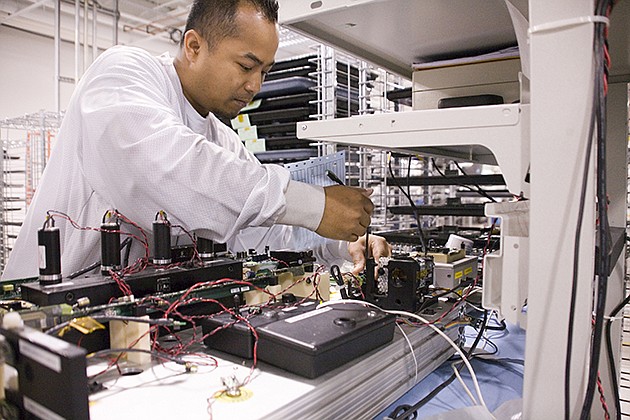- November 24, 2024
-
-
Loading

Loading

Three years ago, Jabil executive David Wahl began to pitch an idea: He wanted to build a center for the giant supply chain and innovative electronic manufacturer to show off its chops.
According to Wahl, a central facility was needed for a few reasons. Most importantly, Jabil had expanded its design and manufacturing capabilities after a number of acquisitions. The company didn't have a good location to showcase the diversity of its work to current and prospective clients. It also didn't have a place to bring together its expanding team.
With 180,000 employees, the $15.7 billion manufacturer operates in 95 sites across 24 countries. Its engineering centers serve markets sprinkled worldwide. Instead of consolidating offices, the new facility would act as a control tower for the different centers — a place dedicated to collaboration and innovation. The facility would bring in 300 representatives from its 10,000 engineers around the world to provide expertise in specific projects.
Executives discussed the “usual suspects” in deciding on a location, Wahl says. It could make sense to put the facility near the company's St. Petersburg headquarters or near the Nypro headquarters outside Boston (Jabil acquired the health care packaging company two years ago). Instead of going with the obvious choices, the firm chose San Jose, Calif.
Silicon Valley was appealing because of the inherent “level of innovation in its current ecosystem,” Wahl says. Venture capital activity in Silicon Valley is five times larger than any other city and there are more Fortune 100 research and development centers in the city than anywhere else. Also, most of the leading technology companies are headquartered there, a big target market for Jabil. Says Wahl: “If we were going to do a showcase and some level of engineering and innovation — this became the winner in that analysis.”
Jabil officials decline to disclose a total construction cost for the project. But the location has been a great fit, Wahl says. More than 1,000 people attended the grand opening of the facility, named Blue Sky, April 30. Of the company's 350 current customers, Jabil has already hosted more than 130 customer meetings in the facility's first four months. “It's an easy gathering place where clients can see more,” he adds.
Even better, these visitors are scheduling return trips because they didn't realize all of Jabil's capabilities, Wahl says. After walking the floor of the 100,000-square-foot building, they're saying, “I didn't know Jabil did this, can I bring back my chief technology officer?” according to Wahl.
A second bonus? Jabil has already seen an increase in new customers. Though executives can't share names due to non-disclosures, Wahl says it's become apparent that companies look for new technology in California. Blue Sky allows Jabil to show off its work; a recent sensor project with Disney for the theme parks' magic bands is one example. “Disney wasn't one of our targeted customers,” Wahl admits. By showcasing that project, the company's doors have opened to new industries, including hospitality, entertainment, sports and even clothing.
But not all aspects of Blue Sky have been easy.
Opening the center has come as a bit of a culture shock to some employees, Wahl says. A lot of the senior technical folks are used to being “heads down in an academic world,” he adds, and may not be naturally gregarious or outgoing.
But the company is doing what it can to nurture collaboration and encourage employees to innovate by stepping out of their comfort zones. “Just like the ecosystem in Silicon Valley, it didn't appear overnight,” Wahl says. “There's no good reason other than a lot of hard work.”